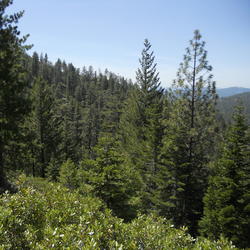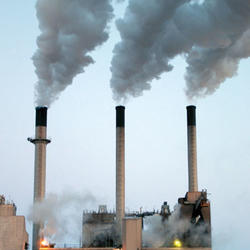Schematic cross section showing examples of chemical, mechanical, and thermal geologic energy storage methods in potential underground settings in a sedimentary basin. This illustration is a higher resolution version of figure 2 of USGS Fact Sheet 2022-3084.
Carbon and Energy Storage, Emissions and Economics (CESEE)
Carbon Dioxide Storage Assessments and Research
The USGS provides national carbon dioxide enhanced oil recovery and associated carbon dioxide storage information
Associated Energy Gases
The USGS characterizes and evaluates the resource potential of energy-related gases such as carbon dioxide, helium, nitrogen, and hydrogen sulfide
Microseismic Monitoring at Decatur, IL
The USGS monitors microseismic activity to better understand the possible hazard associated with deep-well injection of carbon dioxide at Decatur
Above-ground Infrastructure for Storing Excess Energy
Subsurface natural gas storage in the Hutchinson Salt Member in Reno County, Kansas
Carbon Dioxide (CO2) is utilized by industry to enhance oil recovery. Subsurface CO2 storage could significantly impact reduction of CO2 emissions to the atmosphere, but the economics and potential risks associated with the practice must be understood before implementing extensive programs or regulations. Utilization of other energy-related gases such as helium (He), if separated and concentrated from the produced natural gas stream, can make otherwise low-thermal (un-economic) natural gas deposits a viable part of the national natural gas resource base. Geologic energy storage options require additional investigation and assessments of available storage resources.
Federal Lands Greenhouse Gas Emissions and Sequestration in the U.S.

The USGS has produced estimates of the greenhouse gas emissions resulting from the extraction and end-use combustion of fossil fuels produced on Federal lands in the United States, as well as estimates of ecosystem carbon emissions and sequestration.
Downloadable Geologic Carbon Dioxide Sequestration Spatial Data

A list of downloadable geologic carbon dioxide sequestration spatial data and associated geologic reports is available here.
Our interactive web map includes investigated basins, assessed areas, stratigraphic columns, and well density information.
Geologic Carbon Dioxide Utilization Topics
- Assessment Methodologies
- National Carbon Dioxide Storage Assessment Results
- Select Energy Resources Program Carbon Dioxide Publications
- Global Carbon Dioxide Storage Resource Assessments
- Project Staff
- Geologic Carbon Sequestration Project Overview Handout
- Helium Concentrations in United States Wells
The Carbon and Energy Storage, Emissions and Economics (CESEE) project conducts science to:
- Estimate how much oil can be produced by injecting CO2 into reservoirs for enhanced oil recovery
- Estimate the amount of CO2 that could be stored in geologic reservoirs nationwide
- Assess the environmental risks of storing CO2 in underground reservoirs, including the potential for CO2 leakage, impacts to drinking water, and induced seismicity
- Evaluate the origin, distribution, and resource-potential of non-hydrocarbon natural gases
- Evaluate subsurface geologic energy storage options including natural gas storage, compressed air storage, pumped hydroelectric storage, and geothermal storage
During the course of the Carbon and Energy Storage, Emissions and Economics (CESEE) project, the following research and assessment topics are being investigated:
- Methodology Development and Assessment of National Carbon Dioxide Enhanced Oil Recovery and Associated Carbon Dioxide Storage Potential
- Geologic Carbon Dioxide and Energy-related Storage, Gas Resources, and Utilization
- Assessing Emissions from Active and Abandoned Coal Mines
- Geologic Energy Storage
- Induced Seismicity Associated with Carbon Dioxide Geologic Storage
- Economics of Energy Transitions
Slideshows Associated with Project Member Talks:
- National Unplugged Orphan Oil and Gas Well Database - Presentation [.pdf] [3.71 MB]
- Carbon Dioxide Mineralization Feasibility in the United States [.pdf] [3.91 MB]
- Subsurface Carbon and Energy Storage Resource Assessments [.pdf] [1.74 MB]
- Federal lands greenhouse gas emissions and sequestration – a modified EPA methodology [.pdf]
- A Pressure-limited Model to Estimate CO2 Injection and Storage Capacity of Saline Formations: Investigating the Effects of Formation Properties, Model Variables and Presence of Hydrocarbon Reservoirs [.pdf] [1.2 MB]
- Enhanced Oil Recovery and Residual Oil Zone Studies at the U.S. Geological Survey [.pdf] [2.0 MB]
- Overview of USGS Carbon Sequestration - Geologic Research and Assessments Project [.pdf] [2.1 MB]
- Microseismicity Monitoring at the Decatur, IL, CO2 Sequestration Demonstration Site [.pdf] [8.9 MB]
- Status Report: Estimating greenhouse gas emissions from fossil fuels produced from Federal lands [.pdf] [1.2 MB]
- A Probabilistic Assessment Methodology for Carbon Dioxide Enhanced Oil Recovery and Associated Carbon Dioxide Retention [.pdf] [.67 MB]
- A Database and Probabilistic Assessment Methodology for Carbon Dioxide Enhanced Oil Recovery and Associated Carbon Dioxide Retention in the United States [.pdf] [1.7 MB]
- Enhanced Oil Recovery and CO2 Resource Studies at the U.S. Geological Survey [.pdf] [1.2 MB]
- Induced Seismicity Monitoring at the Decatur, IL, CO2 Sequestration Demonstration Site [YouTube]
- U.S. Geological Survey National Assessment of Geologic Carbon Dioxide Storage Resources and Associated Research [.pdf] [2.3 MB]
- U.S. Geological Survey National Assessment of Geologic Carbon Dioxide Storage Resources and Associated Research [.pdf] [2.6 MB]
- National Assessment of Geologic Carbon Dioxide Storage Resources - Results [.pdf] [2.2 MB]
- Development Philosophy of an Assessment Methodology for Hydrocarbon Recovery Potential Using CO2-EOR Associated with Carbon Sequestration [.pdf] [.57 MB]
- U.S. Geological Survey Geologic Carbon Dioxide Storage Resource Assessment of the United States - 2012 Project Update [.pdf] [3.9 MB]
- Examining Salinity Restrictions for CO2 Storage: Suggestions from Basin to Reservoir Scales [.pdf] [1.9 MB]
- Using ArcGIS to Identify Environmental Risk Factors Associated with CO2 Storage [.pdf] [1.7 MB]
- A Probabilistic Assessment Methodology for the Evaluation of Geologic Carbon Dioxide Storage [.pdf] [1.4 MB]
- CO2 Fluid Flow Modeling to Derive the Time Scales of Lateral Fluid Migration [.pdf] [1.2 MB]
- U.S. Geological Survey Geologic Carbon Dioxide Storage Resource Assessment of the United States - Project Update [.pdf] [3.3 MB]
Below are other science projects associated with this project.
Carbon Mineralization
Economics of Energy Transitions
Geologic Energy Storage
Assessing Emissions from Active and Abandoned Coal Mines
Induced Seismicity Associated with Carbon Dioxide Geologic Storage
Geologic Carbon Dioxide and Energy-related Storage, Gas Resources, and Utilization
Methodology Development and Assessment of National Carbon Dioxide Enhanced Oil Recovery and Associated Carbon Dioxide Storage Potential
Below are data or web applications associated with this project.
Carbon Dioxide Storage Resources - California Basins: Chapter Q, Spatial Data
Simulations of hypothetical CO2 leakage and hydrological plume management in an underground source of drinking water at a proposed CO2 storage facility, Kemper County, Mississippi, USA
Federal Lands Greenhouse Gas Emissions and Sequestration in the United States: Estimates 2005-22 - Data
Carbon Dioxide Storage Resources-Anadarko and Southern Oklahoma Basins: Chapter R. Spatial Data
Carbon Dioxide Storage Resources - Appalachian Basin, Black Warrior Basin, Illinois Basin, and Michigan Basin: Chapter P, Spatial Data
Carbon Dioxide Storage Resources-Wind River Basin: Chapter O, Spatial Data
Optimization simulations to estimate maximum brine injection rates in the Illinois Basin
United States Documented Unplugged Orphaned Oil and Gas Well Dataset
National assessment of carbon dioxide enhanced oil recovery and associated carbon dioxide retention resources - data release
Geologic formations and mine locations for potential CO2 mineralization
Dataset of Helium Concentrations in United States Wells
Model of groundwater flow, gas migration, and reactive transport in the Virgin River Basin, SW Utah
Below are multimedia items associated with this project.
Schematic cross section showing examples of chemical, mechanical, and thermal geologic energy storage methods in potential underground settings in a sedimentary basin. This illustration is a higher resolution version of figure 2 of USGS Fact Sheet 2022-3084.
The use of carbon dioxide (CO2) injection for enhanced oil recovery (EOR) can prolong the productivity of many oil reservoirs and increase the U.S. hydrocarbon recoverable resource volume.
The use of carbon dioxide (CO2) injection for enhanced oil recovery (EOR) can prolong the productivity of many oil reservoirs and increase the U.S. hydrocarbon recoverable resource volume.
Below are publications associated with this project.
Temporal and spatial comparison of coal mine ventilation methane emissions and mitigation quantified using PRISMA satellite data and on-site measurements
Managing basin-scale carbon sequestration: A tragedy of the commons approach
Methodology for inclusion of produced and stored carbon dioxide in the U.S. Geological Survey Federal lands greenhouse gas inventory
Federal lands greenhouse gas emissions and sequestration in the United States: Estimates for 2005–22
A methodology to estimate CO2 and energy gas storage resources in depleted conventional gas reservoirs
Exploring the uncertainty of machine learning models and geostatistical mapping of rare earth element potential in Indiana coals, USA
Geologic carbon management options for the North Atlantic-Appalachian Region
A residual oil zone (ROZ) assessment methodology with application to the central basin platform (Permian Basin, USA) for enhanced oil recovery (EOR) and long-term geologic CO2 storage
Reconnaissance survey for potential energy storage and carbon dioxide storage resources of petroleum reservoirs in western Europe
Predicting methane emissions and developing reduction strategies for a Central Appalachian Basin, USA, longwall mine through analysis and modeling of geology and degasification system performance
Geologic energy storage
Analysis of the United States documented unplugged orphaned oil and gas well dataset
Below are data or web applications associated with this project.
Geologic Carbon Dioxide Sequestration Interactive Map
Federal Lands Emissions and Sequestration in the United States: Estimates 2005-14
Below are news stories associated with this project.
Below are FAQ associated with this project.
How does carbon get into the atmosphere?
Has the USGS made any Biologic Carbon Sequestration assessments?
How much carbon dioxide does the United States and the World emit each year from energy sources?
Which area is the best for geologic carbon sequestration?
How much carbon dioxide can the United States store via geologic sequestration?
What’s the difference between geologic and biologic carbon sequestration?
What is carbon sequestration?
Below are partners associated with this project.
Carbon Dioxide (CO2) is utilized by industry to enhance oil recovery. Subsurface CO2 storage could significantly impact reduction of CO2 emissions to the atmosphere, but the economics and potential risks associated with the practice must be understood before implementing extensive programs or regulations. Utilization of other energy-related gases such as helium (He), if separated and concentrated from the produced natural gas stream, can make otherwise low-thermal (un-economic) natural gas deposits a viable part of the national natural gas resource base. Geologic energy storage options require additional investigation and assessments of available storage resources.
Federal Lands Greenhouse Gas Emissions and Sequestration in the U.S.

The USGS has produced estimates of the greenhouse gas emissions resulting from the extraction and end-use combustion of fossil fuels produced on Federal lands in the United States, as well as estimates of ecosystem carbon emissions and sequestration.
Downloadable Geologic Carbon Dioxide Sequestration Spatial Data

A list of downloadable geologic carbon dioxide sequestration spatial data and associated geologic reports is available here.
Our interactive web map includes investigated basins, assessed areas, stratigraphic columns, and well density information.
Geologic Carbon Dioxide Utilization Topics
- Assessment Methodologies
- National Carbon Dioxide Storage Assessment Results
- Select Energy Resources Program Carbon Dioxide Publications
- Global Carbon Dioxide Storage Resource Assessments
- Project Staff
- Geologic Carbon Sequestration Project Overview Handout
- Helium Concentrations in United States Wells
The Carbon and Energy Storage, Emissions and Economics (CESEE) project conducts science to:
- Estimate how much oil can be produced by injecting CO2 into reservoirs for enhanced oil recovery
- Estimate the amount of CO2 that could be stored in geologic reservoirs nationwide
- Assess the environmental risks of storing CO2 in underground reservoirs, including the potential for CO2 leakage, impacts to drinking water, and induced seismicity
- Evaluate the origin, distribution, and resource-potential of non-hydrocarbon natural gases
- Evaluate subsurface geologic energy storage options including natural gas storage, compressed air storage, pumped hydroelectric storage, and geothermal storage
During the course of the Carbon and Energy Storage, Emissions and Economics (CESEE) project, the following research and assessment topics are being investigated:
- Methodology Development and Assessment of National Carbon Dioxide Enhanced Oil Recovery and Associated Carbon Dioxide Storage Potential
- Geologic Carbon Dioxide and Energy-related Storage, Gas Resources, and Utilization
- Assessing Emissions from Active and Abandoned Coal Mines
- Geologic Energy Storage
- Induced Seismicity Associated with Carbon Dioxide Geologic Storage
- Economics of Energy Transitions
Slideshows Associated with Project Member Talks:
- National Unplugged Orphan Oil and Gas Well Database - Presentation [.pdf] [3.71 MB]
- Carbon Dioxide Mineralization Feasibility in the United States [.pdf] [3.91 MB]
- Subsurface Carbon and Energy Storage Resource Assessments [.pdf] [1.74 MB]
- Federal lands greenhouse gas emissions and sequestration – a modified EPA methodology [.pdf]
- A Pressure-limited Model to Estimate CO2 Injection and Storage Capacity of Saline Formations: Investigating the Effects of Formation Properties, Model Variables and Presence of Hydrocarbon Reservoirs [.pdf] [1.2 MB]
- Enhanced Oil Recovery and Residual Oil Zone Studies at the U.S. Geological Survey [.pdf] [2.0 MB]
- Overview of USGS Carbon Sequestration - Geologic Research and Assessments Project [.pdf] [2.1 MB]
- Microseismicity Monitoring at the Decatur, IL, CO2 Sequestration Demonstration Site [.pdf] [8.9 MB]
- Status Report: Estimating greenhouse gas emissions from fossil fuels produced from Federal lands [.pdf] [1.2 MB]
- A Probabilistic Assessment Methodology for Carbon Dioxide Enhanced Oil Recovery and Associated Carbon Dioxide Retention [.pdf] [.67 MB]
- A Database and Probabilistic Assessment Methodology for Carbon Dioxide Enhanced Oil Recovery and Associated Carbon Dioxide Retention in the United States [.pdf] [1.7 MB]
- Enhanced Oil Recovery and CO2 Resource Studies at the U.S. Geological Survey [.pdf] [1.2 MB]
- Induced Seismicity Monitoring at the Decatur, IL, CO2 Sequestration Demonstration Site [YouTube]
- U.S. Geological Survey National Assessment of Geologic Carbon Dioxide Storage Resources and Associated Research [.pdf] [2.3 MB]
- U.S. Geological Survey National Assessment of Geologic Carbon Dioxide Storage Resources and Associated Research [.pdf] [2.6 MB]
- National Assessment of Geologic Carbon Dioxide Storage Resources - Results [.pdf] [2.2 MB]
- Development Philosophy of an Assessment Methodology for Hydrocarbon Recovery Potential Using CO2-EOR Associated with Carbon Sequestration [.pdf] [.57 MB]
- U.S. Geological Survey Geologic Carbon Dioxide Storage Resource Assessment of the United States - 2012 Project Update [.pdf] [3.9 MB]
- Examining Salinity Restrictions for CO2 Storage: Suggestions from Basin to Reservoir Scales [.pdf] [1.9 MB]
- Using ArcGIS to Identify Environmental Risk Factors Associated with CO2 Storage [.pdf] [1.7 MB]
- A Probabilistic Assessment Methodology for the Evaluation of Geologic Carbon Dioxide Storage [.pdf] [1.4 MB]
- CO2 Fluid Flow Modeling to Derive the Time Scales of Lateral Fluid Migration [.pdf] [1.2 MB]
- U.S. Geological Survey Geologic Carbon Dioxide Storage Resource Assessment of the United States - Project Update [.pdf] [3.3 MB]
Below are other science projects associated with this project.
Carbon Mineralization
Economics of Energy Transitions
Geologic Energy Storage
Assessing Emissions from Active and Abandoned Coal Mines
Induced Seismicity Associated with Carbon Dioxide Geologic Storage
Geologic Carbon Dioxide and Energy-related Storage, Gas Resources, and Utilization
Methodology Development and Assessment of National Carbon Dioxide Enhanced Oil Recovery and Associated Carbon Dioxide Storage Potential
Below are data or web applications associated with this project.
Carbon Dioxide Storage Resources - California Basins: Chapter Q, Spatial Data
Simulations of hypothetical CO2 leakage and hydrological plume management in an underground source of drinking water at a proposed CO2 storage facility, Kemper County, Mississippi, USA
Federal Lands Greenhouse Gas Emissions and Sequestration in the United States: Estimates 2005-22 - Data
Carbon Dioxide Storage Resources-Anadarko and Southern Oklahoma Basins: Chapter R. Spatial Data
Carbon Dioxide Storage Resources - Appalachian Basin, Black Warrior Basin, Illinois Basin, and Michigan Basin: Chapter P, Spatial Data
Carbon Dioxide Storage Resources-Wind River Basin: Chapter O, Spatial Data
Optimization simulations to estimate maximum brine injection rates in the Illinois Basin
United States Documented Unplugged Orphaned Oil and Gas Well Dataset
National assessment of carbon dioxide enhanced oil recovery and associated carbon dioxide retention resources - data release
Geologic formations and mine locations for potential CO2 mineralization
Dataset of Helium Concentrations in United States Wells
Model of groundwater flow, gas migration, and reactive transport in the Virgin River Basin, SW Utah
Below are multimedia items associated with this project.
Schematic cross section showing examples of chemical, mechanical, and thermal geologic energy storage methods in potential underground settings in a sedimentary basin. This illustration is a higher resolution version of figure 2 of USGS Fact Sheet 2022-3084.
Schematic cross section showing examples of chemical, mechanical, and thermal geologic energy storage methods in potential underground settings in a sedimentary basin. This illustration is a higher resolution version of figure 2 of USGS Fact Sheet 2022-3084.
The use of carbon dioxide (CO2) injection for enhanced oil recovery (EOR) can prolong the productivity of many oil reservoirs and increase the U.S. hydrocarbon recoverable resource volume.
The use of carbon dioxide (CO2) injection for enhanced oil recovery (EOR) can prolong the productivity of many oil reservoirs and increase the U.S. hydrocarbon recoverable resource volume.
Below are publications associated with this project.
Temporal and spatial comparison of coal mine ventilation methane emissions and mitigation quantified using PRISMA satellite data and on-site measurements
Managing basin-scale carbon sequestration: A tragedy of the commons approach
Methodology for inclusion of produced and stored carbon dioxide in the U.S. Geological Survey Federal lands greenhouse gas inventory
Federal lands greenhouse gas emissions and sequestration in the United States: Estimates for 2005–22
A methodology to estimate CO2 and energy gas storage resources in depleted conventional gas reservoirs
Exploring the uncertainty of machine learning models and geostatistical mapping of rare earth element potential in Indiana coals, USA
Geologic carbon management options for the North Atlantic-Appalachian Region
A residual oil zone (ROZ) assessment methodology with application to the central basin platform (Permian Basin, USA) for enhanced oil recovery (EOR) and long-term geologic CO2 storage
Reconnaissance survey for potential energy storage and carbon dioxide storage resources of petroleum reservoirs in western Europe
Predicting methane emissions and developing reduction strategies for a Central Appalachian Basin, USA, longwall mine through analysis and modeling of geology and degasification system performance
Geologic energy storage
Analysis of the United States documented unplugged orphaned oil and gas well dataset
Below are data or web applications associated with this project.
Geologic Carbon Dioxide Sequestration Interactive Map
Federal Lands Emissions and Sequestration in the United States: Estimates 2005-14
Below are news stories associated with this project.
Below are FAQ associated with this project.
How does carbon get into the atmosphere?
Has the USGS made any Biologic Carbon Sequestration assessments?
How much carbon dioxide does the United States and the World emit each year from energy sources?
Which area is the best for geologic carbon sequestration?
How much carbon dioxide can the United States store via geologic sequestration?
What’s the difference between geologic and biologic carbon sequestration?
What is carbon sequestration?
Below are partners associated with this project.

















